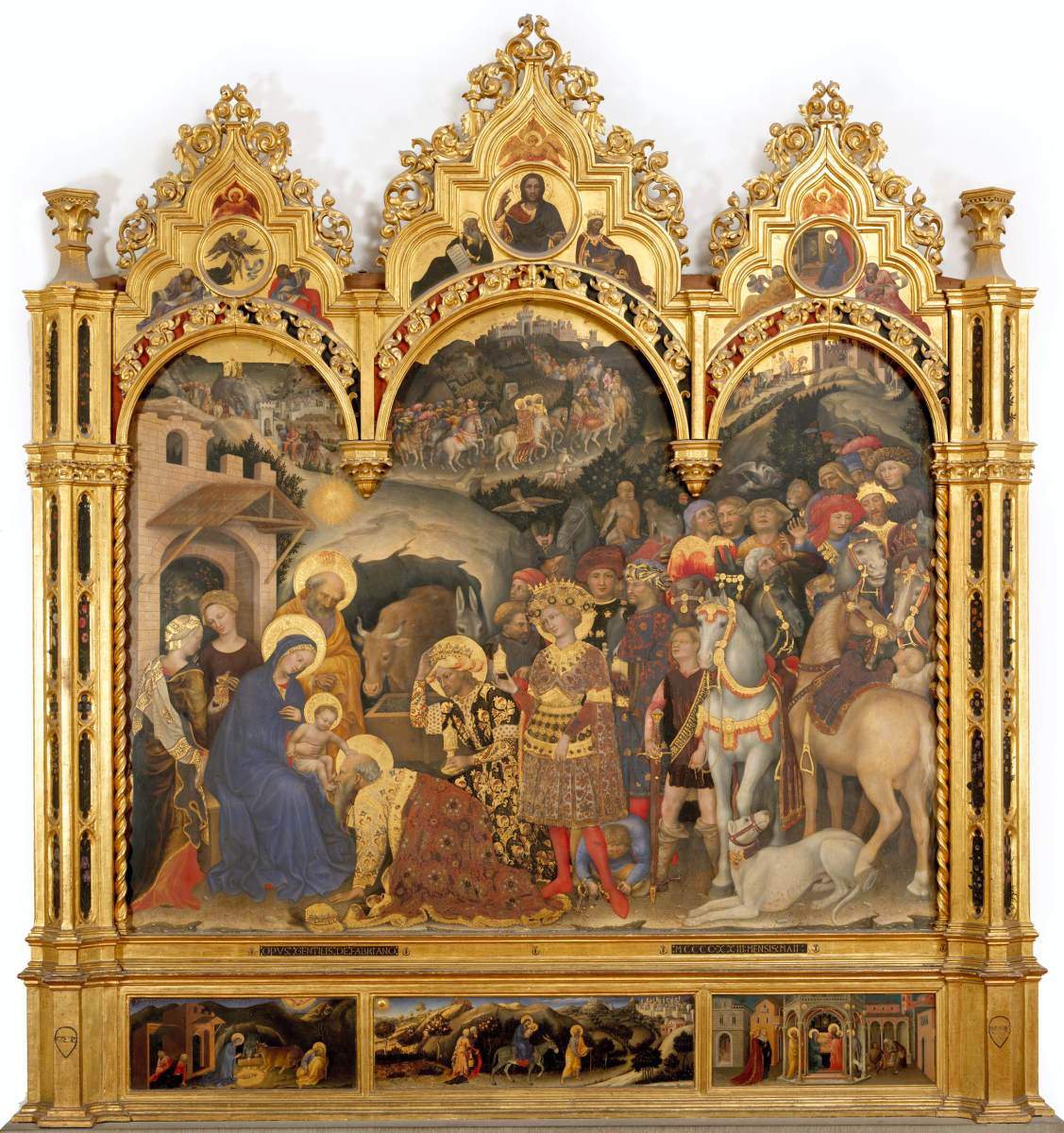Supercult. Pietro Zampetti on Gentile da Fabriano.
The Adoration of the Magi, the only work that has come down to us intact, ordered from the painter by the richest man in Florence, Palla Strozzi, for his own Chapel in Santa Trinita in Florence-whose architectural execution had been entrusted to Ghiberti-and now on display at the Uffizi Gallery. Signed in 1425, this fabulous assemblage-a theme dear to the “courtly ” taste that had ways of expanding the tale with inventions and fables-is an assemblage of imaginative hyperbole, the ultimate in courtly pictorial culture, where dawn and dusk, fables and inventions, sacred and profane are interwoven with verifiable truths, sweetness and melancholy, violence and death, where there is all the figurative transposition of a world that was fading away. The Magi’s ride is seen in a single space but in successive moments: from the appearance of the star to the Magi on the hill to the left, on this side of an expanse of sea, to the long ride, to the walk through mountains valleys, villages and castles to the foreground, to the final limelight of this luxurious scenic vision, where they arrive, after much traveling and wandering among hunting scenes, the Kings who stop their way harnessed, and dismount from their horses to pay homage to the Child Jesus.
An arcane and elegant world, with exotic annotations, to be explained also “by the snobbery and aristocratizing tastes of the comittente,” a very rich merchant, but also a man of culture. And Florence, then, was a city that looked far ahead precisely because of its merchants and refined products that reached every corner of the known world. In that uberbright painting, made of gilded frames, colors, sacred events, worldliness, and unsurpassed preciousness, there is the whole universe, beginning with the Eternal and the prophets. The crowding in the foreground of men and horses is such that it looks like the reception of a festival, a tournament, a parade, where a refined and indifferent world shows itself, makes a fine show of itself, like the young king in the center, with his precious robe quilted with gold and embroidery. He has the appearance of a mannequin to solemnize the preciousness of dress and the sustained elegance of his behavior. The event is a splendid parade, there is a lack of any solicitation of the profound meaning it contains for Christendom (how different from the dramatic and severe interpretation of that same Gospel episode that Leonardo would be able to offer a few decades later in that same Florentine Gallery).

But on closer inspection, not all is gold and splendor, not all is exhausted and almost cloying, however lofty, depiction. In the predella, almost in contradistinction, three episodes: the Nativity, the Flight into Egypt, and the Presentation in the Temple (of this one the original is in the Louvre here is a copy) propose solitary silent scenes, where ostentatious presences disappear, and events dominate. The “nocturne” of the Nativity under the sky quilted with stars is an absolute novelty because of that light that radiates from the Child, beats on the facade of the little house, there where a girl is asleep: and it seems almost the fantasy of a metaphysical painter, a vision immersed in mystery and in the expectation of a feared event. That atmosphere of expectation has its sequel in the Flight into Egypt, where the sun is high, but the silence is deep in the gaze of Jesus and the Madonna, with St. Joseph preceding and the gentlewomen watching and commenting. It is a resigned and sorrowful atmosphere, so far from the total indifference of the scene above; a sorrowful feeling looms almost as in Lucia’s farewell in The Betrothed. But the elegant gentlewomen are a reminder of the Florentine reality, the closest one, experienced firsthand. And note how similar they are, almost participants in the same party with the “models” drawn by Pisanello, in the sheets of the Bayonne Museum.
Last, but not least, the attraction of this great work that is the Adoration, the extreme experience of a figuration that was about to dissolve and give way to a new taste, is the “floral” decoration of the pierced pillars that close the marvelous machine laterally. There, where generally peeped in similar compositions-until Bellini’s Pesaro altarpiece-figures of overlapping saints, Gentile invented an assemblage of grasses and flowers, almost a homage and a final farewell to the flowery meadows dear to Lombard painting of the time. But those presences here take on a newly coined value, that of the “still life,” as Grassi has well noted, followed by Bellosi, who states, “it cannot but leave us astonished that enthusiasts of this particular area of art have not highlighted this strangely anticipatory aspect of Gentile.” And indeed herbs and flowers, strawberries and cherries, all that nature can offer to our admiring attention, the artist has gathered here with a precision of rendering to interest art and science. And this is also why the Adoration appears to be an emblematic work: it was so when it was placed in the Strozzi Chapel in Santa Trinita, it is still so today at the distance of more than five centuries.
---
Pietro Zampetti, Gentile and the painters of Fabriano, Nardini, Prato, 1997, pp. 99-100
 |
| Supercult. Pietro Zampetti on Gentile da Fabriano. |
Warning: the translation into English of the original Italian article was created using automatic tools. We undertake to review all articles, but we do not guarantee the total absence of inaccuracies in the translation due to the program. You can find the original by clicking on the ITA button. If you find any mistake,please contact us.




























